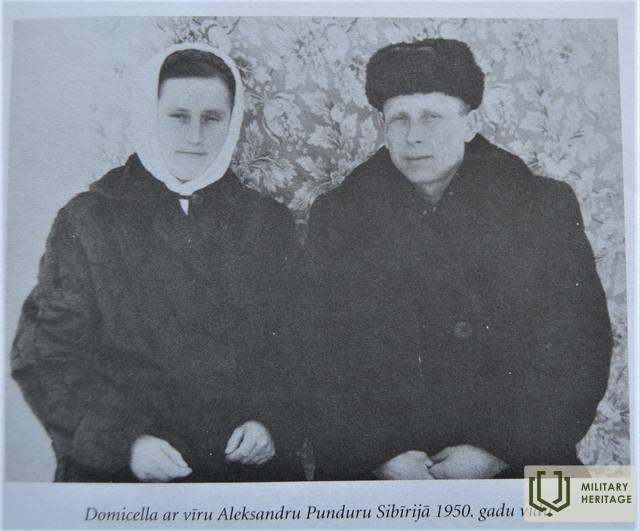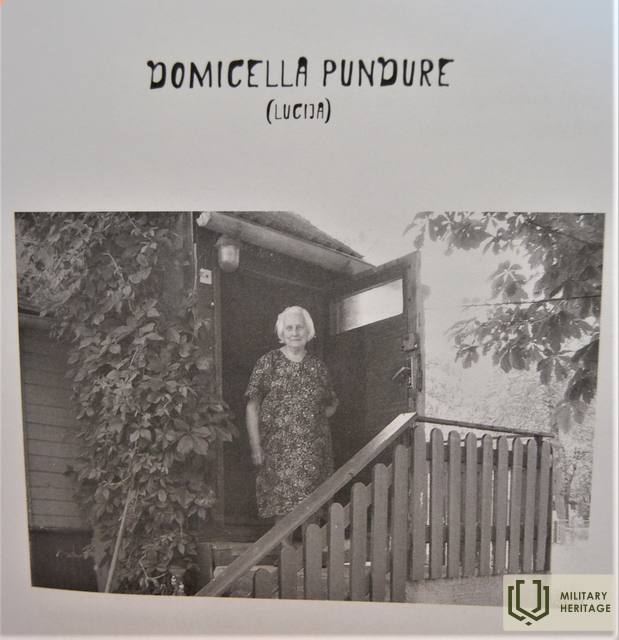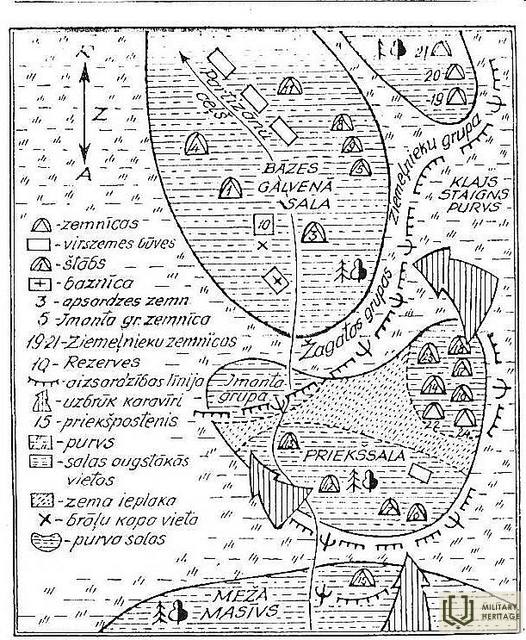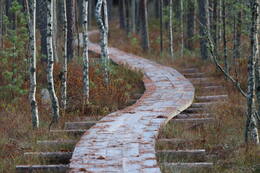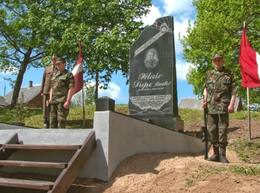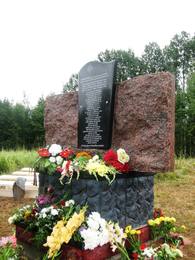Forest Daughter Domicella Dwarf (Lucia)
Domicella Pundure is 90. On May 3, 2018, at Riga Castle, she received the Viesturas Order from the hands of President Raimonds Vējonis for special merits in the national resistance movement and the defense of the country's independence. Domicella Pundure is the last witness to the Battle of Stompaku Marsh.
Domicella Pundure is a national partisan who spent more than a month in the Stompaku swamp settlement from February 1945, where about 360 partisans lived at the time, including women, children and the elderly. She got married in 1948, but in 1949 her whole family was deported to Siberia, to the Omsk region. She returned to Latvia in April 1960. The young family bought a house in the then collective farm "Borec", worked in the collective farm's field brigade. When her husband died, Domicella Pundure moved to Balvi in the autumn of 1987. Already retired, she worked in the hotel buffet for a couple of years.
The life story of Domicella Pundur can be read in Sanita Reinsone's book "Meža meitas" (The Daughters of the Forest).
Born on December 1, 1927 in the Kručinova family home in Šķilbēni parish. After completing four grades at the nearby Augstasilas elementary school, Domicella began working on her father's farm.
“My father was a guard during the Free State of Latvia, but during the German occupation he worked in the Šķilbēni police. When the war front crossed again in July-August 1944, we were not at home. The neighbors were local Russians and they persuaded us to leave. We left, but they didn’t go too far, they stayed with relatives here in Balvi. So after a while we drove back.
But my father never left and never lived at home again. At first he didn't show up at all, but then we met him. He didn't show up in Ščilbės anymore. They lived in a small group, only later did they join a larger group. Then my father went to the Stompāku swamp. Later, when the forest brothers gathered more, the Chekists started terrorizing everyone, and when they sent me a summons to go to work in the peat bog, my father took me with him in February 1945. They took me on horseback to Stompāku. I went into the forest with what I had on my back, and that was all. The rosary, yes, I had it with me - it had to be with me. And we went, prayed, and God protected us. Whoever was supposed to fall, fell.
The Stompak forest was not thick, and the camp was not that far from the road. We did not drive on the main road, there you could drive straight through the forests. In winter, when the forest work was done, the roads were already built along the lines. Everyone in the camp was given a name. My father had Irbītis, and I think I had Lucija. Until the fighting started in the camp, we did what we were told in the camp. There was one elder in each bunker, and he was in command. I lived in the bunker with my father. It was not cold in the winter. We had a small stove where we cooked food. The walls were made of logs. They were high enough that you could stand up, and there were bunks where someone slept on top and someone on the bottom. Some bunkers were bigger, some smaller. There were some with more people, some with fewer people. There were also horses. There were three horses by our own bunker. They had huts like that made of spruce branches. They also fell in battle.
In general, there were quite a few women in those Stompaks. There were also children. Small children. …There was even a special bunker where they baked bread. But in general, in each bunker they took care of their own food – wherever they could get it, they went to relatives or to family who had it at home. The food was like from the countryside. As in winter, there was slaughtered pigs, meat, cottage cheese, milk. There was no need to starve… I was told that the bunkers in Stompaks were numbered or that those numbers have now been introduced. Ours was the sixth bunker.
We didn't really walk around the bunkers in the camp and didn't see anyone else. We met others in the camp church and here and there. The church was in the camp itself. My husband and his brother had helped build it. It was such a small bunker, no more than twenty people could fit inside. Catholics came to the church. Services were held every morning. And they even heard confessions there. The priest was from Šķilbėni – Ludvigs Štagars.
About that day when there was a battle on March 2-3, 1945. The shooting started early in the morning. I didn't know what was happening. People were running around the camp. My father's sister and I were in the church. And we just squatted there all day. Later, the wounded began to be brought to us. There were a lot of them. We had a paramedic from Viļaka, Roman. He was our commander. We helped as best we could - we bandaged the wounded, gave them what they needed, and did everything else. There I met my future husband. He was wounded in the leg. And that's when everything started for us.
In general, it was safe in that big camp, but that day of the battle… it was scary. Horror, what a noise there was! We were just scared. After the battle, they were already talking about all sorts of things, but still, you see, our men fought back. The men had all kinds of weapons, there were quite a few of them. The most important person in the camp was Pēteris Supe, but I didn't see him. And then that very evening, we went out. The wounded were taken away on horses. Those of us who were completely, as they say, healthy, all strong, went out. I don't remember how many of us there were, but there weren't many. We wandered through the forest, through the swamp, through the forest. The men had weapons with them, of course. We walked at night. The next evening, we came out to the former Bareca, to the house right on the edge of the forest. They gave us tea to drink. And they probably gave us some bread, because we left completely empty-handed, everything that was in the bunker stayed there.
And then our group broke up. My father and I went home. But he didn’t live at home. And so no one touched me anymore, I didn’t go anywhere to apply or register, I lived in the house. It turns out that I lived in the forest for a month.”
On March 2, 1945, when there were about 300 people in the camp, a unit of Soviet troops attacked the swamp. For almost 24 hours, the forest brothers resisted the enemy's superior force of about 500 people. 28 partisans and 46 Soviet soldiers fell in battle or died from their wounds. The remains of the forest brothers who were killed were displayed in Viļaka and some nearby villages to intimidate the local population.
http://www.balvurcb.lv/kb/?View=entry&EntryID=1078
Quotes from Sanita Reinsone's book "Daughters of the Forest"
Related timeline
Related topics
Related objects
Trail and partisan memorial in Stompaki bog
During World War II, one of the largest national partisan camps in the Baltic states was situated in Stompaki Swamp. Today, the territory is included in the nature reserve “Stompaki swamp”. The settlement sites located on the islands in the swamp can be reached via a marked footpath.
In early 1945, about 350 to 360 people, including 40 to 50 women, lived at the camp of National Partisans in Stompaki Swamp. The camp consisted of 24 residential bunkers – buildings that were half-immersed into the ground and could accommodate 3–8 people. There was a bakery, a church bunker and three above-ground rails for horses. Partisans from the camp carried out attacks against officials of the occupation regime. On 2–3 March 1945, the Battle of Stompaki took place here – the largest battle in the history of Latvian national partisans. The 350–360 partisans in the camp were attacked by the 143rd Rifle Regiment of NKVD and local fighters of the so-called ‘istrebitel’ (eliminators) battalion – 483 men in total. The battle lasted for the entire duration of the day on 2 March. On the night of 3 March, the partisans managed to break out of the camp and retreat to their previous base camps. The battle resulted in 28 casualties among partisans, while the NKVD force lost 32 fighters.
Today, the site of the Stompaki camp is home to three restored bunkers – a church, a headquarters and a residential bunker – as well as 21 sites of former bunkers. Information boards about the camp and the battle have been installed at the site. Guided tours can be booked.
Private Exhibition “Abrene Rooms”
The Private exhibition “Abrene Rooms” is located in the town of Viļaka, in a building with a diverse history. Initially, the building was located on the old Marienhausen market square, later it housed apartments, offices and various shops, and during World War II, it was the Latvian self-defence headquarters, the Gestapo and also the Cheka. Several exhibitions reveal diverse events and historical periods in the town of Viļaka and its nearest vicinity covering the time period from 1920 to 1960 when Viļaka was part of Jaunlatgale, later Abrene, district. The exhibit features items from the national partisan camp in Stompaki Swamp, which are related to the national partisan movement in the Latgale region. Documents and photos associated with the War of Independence are also on display. The latest exhibition is dedicated to the once-famous motocross track “Baltais briedis”.
Monument to the commander of the North-Eastern national partisans Pēteris Supe - "Cinītis"
In honor of the memory of the national partisan commander Pēteris Supe, a monument dedicated to him was unveiled in Viļaka on May 28, 2005. It is located near the Viļaka Catholic Church, on the edge of the trenches dug during the war, where the Chekists buried the national partisans who were shot. Under the monument dedicated to P. Supe, a capsule with the names of 386 fallen national partisans, descriptions of battles and materials about the partisan commander is placed. The words are carved into the stone: "To you, Latvia, I remained faithful until my last breath."
The monument was designed by Pēteris Kravalis.
Nearby is a memorial to the Latvian freedom fighters who fell in Stompaku Forest and other battle sites and were murdered by the Chekists in 1944-1956.
On June 20, 2008, a granite plaque was unveiled on the right wall with the names of 55 fallen partisans arranged in three columns.
The monument was erected at the site where the communist occupation authorities had once exhibited the remains of murdered partisans to intimidate the rest of the population.
On the adjacent plaque are engraved words of gratitude to Pēteris Supe and a poem by Bronislava Martuževa:
"Get up, Peter Supe,
Soul, fight in the war!
Today is your blood sacrifice,
Risen among the people.
Go out and live forever
In the strength and vigor of youth,
It flutters, flutters, flutters
"In the rising flag!"
Monument to the participants of the resistance movement in Stompaki
Located 15 km from Balvi in the direction of Viļaka, on the right side of the road.
A memorial sign is visible.
A memorial to the participants of the resistance movement, dedicated to the memory of the national partisans of Pēteris Supe who fell in the battles of March 2 and 3, 1945, was unveiled on the side of the Balvu - Viļakas highway opposite the Stompaku swamp on August 11, 2011, on the Day of Remembrance of Latvian Freedom Fighters. At the end of July, a capsule with a message for future generations was embedded in the foundation of the monument. A document with the names of 28 national partisans who fell in the battles of March 2 and 3, 1945 is placed in the capsule.
"In February 1945, on the islands of the Stompaku swamp, which the people began to call the Stompaku swamp islets, 2 km from the Balvi - Viļaka highway, the largest national partisan camp in Latvia was established, where 360 people lived in 22 dugouts. Among them were some legionnaires who, when the legion division retreated, had remained at their father's house with all their weapons. In order to destroy the partisans, on March 2, 1945, soldiers from two Cheka battalions attacked the dugouts together with destroyers, who also had four mortars in their armament. The fighting lasted all day, the partisans resisted stubbornly, and the attackers suffered heavy losses, so that they were unable to take the camp and destroy the partisans. 28 residents of the Stompaku swamp had also fallen in the battle or died from serious injuries. The next night, the partisans broke through the camps with a battle "the siege and left undefeated" - this is what Zigfrīds Berķis, the chairman of the Commission for the Affairs of the National Resistance Movement Participants of the Awards Department, writes about the Battle of Stompak.




